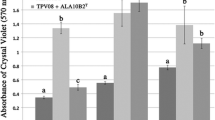Summary
A comparison is made between Rhizobium leguminosarum strains PRE, effective on both pea and broad bean, and PF2, effective on pea and almost ineffective on broad bean. The former develops regular, branched bacteroids on both hosts. Strain PF2 on pea first develops regular bacteroids which then become spherical. On broad bean, PF2 remains mostly in the rod form though few branched bacteroids are present. Other strains which show the same host-induced morphogenetic development as PF2 are all effective on pea and almost ineffective on broad bean.
Strains PF2 has a labile structure which causes a problem during the preparation of bacteroid suspensions. Mercaptoethanol increases ethylene production by PF2 nodule brei but not by PRE nodule brei. Also sonication strongly increases ethylene production by PF2 nodule brei, and inhibits ethylene production by PRE nodule brei. Molybdenum content of both PRE and PF2 cells (including both bacteroids and bacterial cells) of broad bean nodules is the same. Morphological forms do not seem to be related with nitrogenase activity.
The manuscript was prepared for publication by members of the department.
Similar content being viewed by others
Reference
Bergersen, F. J., Some properties of nitrogen-fixing breis prepared from soybean root nodules. Biochem. Biophys. Acta 130, 304–312 (1966).
Beyerinck, M. W., Die Bakterien der Papilionaceenknöllchen. Bot. Ztg. 46, 726–735 (1888).
Chen, H. K. and Thornton, H. G., The structure of ‘ineffective nodules’ and its influence on N2 fixation. Proc. Roy. Soc. B. 129, 208–229 (1940).
Child, J. J., Nitrogen fixation by a Rhizobium sp. in association with non-leguminous plant cell cultures. Nature London 253, 350–351 (1975).
Fred, E. B., Baldwin, J. L. and McCoy, E., The root nodule bacteria and leguminous plants. Univ. Wisconsin Studies in Sci. Madison, Wisc. 343 p. (1932).
Gibson, A. H., Child, J. J., Pagan, J. D. and Scowcroft, W. R., The induction of nitrogenase activity in Rhizobium by non-legume plant cells. Planta 128, 283–239 (1976).
Griffin, R. L., Ultramicrotomy. Baillière Tindall. London. 93 p. (1972).
Helz, G. E., Baldwin, J. L. and Fred, E. B., Strain variations and host specificity of the root nodule bacteria of the pea group. J. Agric. Res. U.S. 35, 1039–1055 (1927).
Jansen van Rensburg, H., Hahn, J. S. and Strijdom, B. W., Morphological development of Rhizobium bacteroids in nodules of Arachis hypogaea L. Phytophylactica 5, 119–122 (1973).
Jordan, D. C., The bacteroids of the genus Rhizobium. Bacteriol. Rev. 26, 119–141 (1962).
Lie, T. A., The effect of low pH on different phases of nodule formation on pea plants. Plant and Soil 31, 391–406 (1969).
McComb, J. A., Elliot, J. and Dilworth, M. J., Acetylene reduction by Rhizobium in pure culture. Nature London 256, 409–410 (1975).
Nobbe, F., Hiltner, L. and Schmid, E., Versuche über die Biologie der Knöllchenbakterien der Leguminosen, insbesondere über die Frage der Arteinheit derselben. Landwirtsch. Vers. Stn. 45, 1–27 (1895).
Scowcroft, W. R. and Gibson, A. H., Nitrogen fixation by Rhizobium associated with tobacco and cow pea cell cultures. Nature London 253, 351–352 (1975).
Staphorst, J. L. and Strijdom, B. W., Some observations on the bacteroids in nodules of Arachis spp. and the isolation of Rhizobia from these nodules. Phytophylactica 4, 87–92 (1972).
Tjepkema, J. and Evans, H. J., Nitrogen fixation by free-living Rhizobium in a defined liquid medium. Biochem. Biophys. Res. Commun. 65, 625–628 (1975).
Vincent, J. M., Root nodule symbiosis with Rhizobium. In The Biology of Nitrogen Fixation; ed. A., Quispel North Holland Publishity Co. Amsterdam. pp. 265–341 (1974).
Wieringa, K. T. and Bakhuis, J. A., Chromatography as a means of selecting effective strains of Rhizobia. Plant and Soil 8, 254–262 (1957).
Wilson, D. O. and Reisenauer, H. M., Determination of leghemoglobin in legume nodules. Anal. Biochem. 6, 27–30 (1963).
Additional information
This study was carried out by the late E. H. R. van den Berg (1942–1974) in the Laboratory of Microbiology at Wageningen in partial fulfilment of the requirements for the degree of Doctor of Sciences
Rights and permissions
About this article
Cite this article
Van den Berg, E.H.R. The effectiveness of the symbiosis of Rhizobium leguminosarum on pea and broad bean. Plant Soil 48, 629–639 (1977). https://doi.org/10.1007/BF00145773
Received:
Issue Date:
DOI: https://doi.org/10.1007/BF00145773




